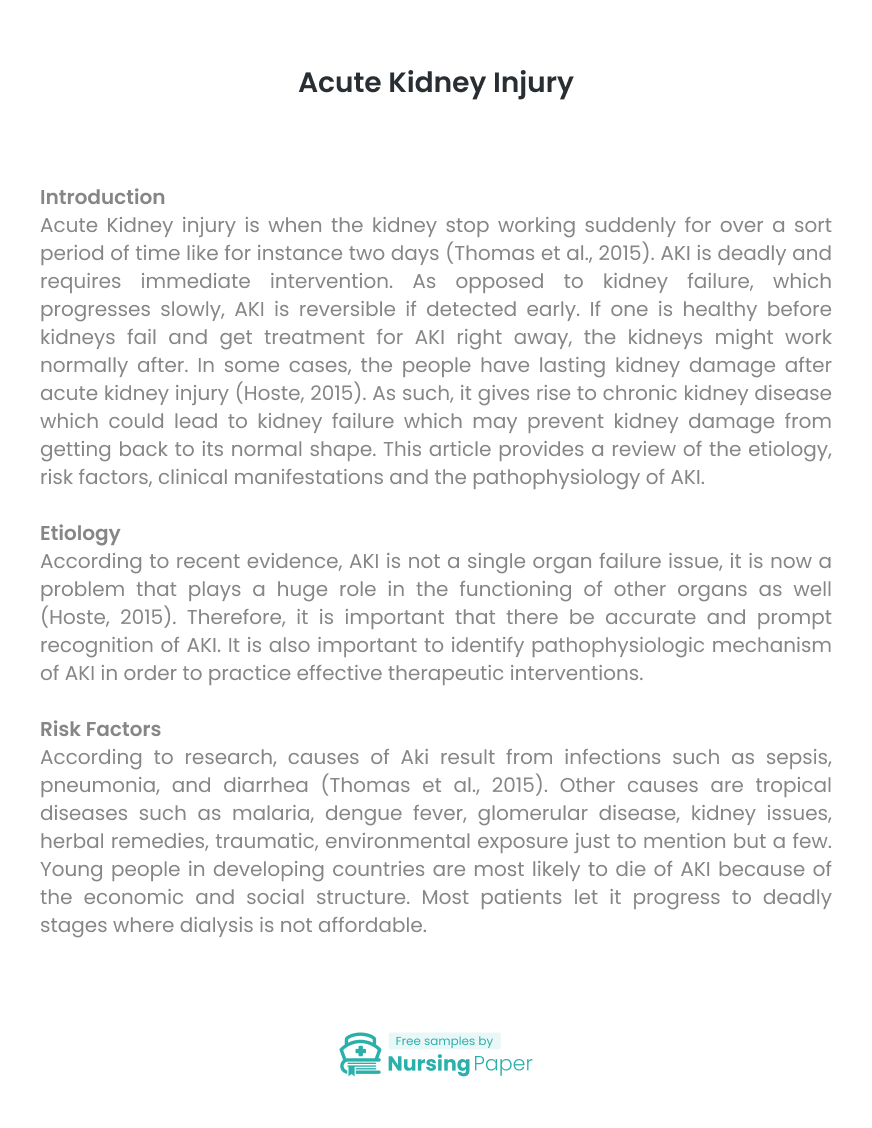
Introduction
Acute Kidney injury is when the kidney stop working suddenly for over a sort period of time like for instance two days (Thomas et al., 2015). AKI is deadly and requires immediate intervention. As opposed to kidney failure, which progresses slowly, AKI is reversible if detected early. If one is healthy before kidneys fail and get treatment for AKI right away, the kidneys might work normally after. In some cases, the people have lasting kidney damage after acute kidney injury (Hoste, 2015). As such, it gives rise to chronic kidney disease which could lead to kidney failure which may prevent kidney damage from getting back to its normal shape. This article provides a review of the etiology, risk factors, clinical manifestations and the pathophysiology of AKI.
Etiology
According to recent evidence, AKI is not a single organ failure issue, it is now a problem that plays a huge role in the functioning of other organs as well (Hoste, 2015). Therefore, it is important that there be accurate and prompt recognition of AKI. It is also important to identify pathophysiologic mechanism of AKI in order to practice effective therapeutic interventions.


Risk Factors
According to research, causes of Aki result from infections such as sepsis, pneumonia, and diarrhea (Thomas et al., 2015). Other causes are tropical diseases such as malaria, dengue fever, glomerular disease, kidney issues, herbal remedies, traumatic, environmental exposure just to mention but a few. Young people in developing countries are most likely to die of AKI because of the economic and social structure. Most patients let it progress to deadly stages where dialysis is not affordable.
Pathophysiology
AKI pathophysiology is quite complex and Ischaemia is the most common cause of AKI which can take place because of reasons such as physiological adaptations- a response in which blood reduces flow in order to balance to a certain level (Hoste, 2015). However, when there is insufficient delivery of oxygen and metabolic substances, it can lead to organ dysfunction. During Ischemia, it affects all segments of the nephron and it loses its ability to filter leading to toxin accumulation surrounding the epithelial cells.
Clinical Manifestations
The treatment for AKI depends on its cause. For most people, it is important that they stay in the hospital until their kidneys start the normal functioning (Thomas et al., 2015). During treatment, the patient is given temporary hemodialysis to help the kidneys with the functioning till full recovery as well as medicine to control minerals and treatment to keep blood fluids in check. It is equally important to have a kidney-friendly diet.

Reducing Risks
This impacts the approach I take as nurse with a patient with AKI. I have to make sure that the patients are taking the recommended doses and on time. It is also necessary that I check how often the patients are taking water because it helps them with hydration especially the older patients. Other things to consider is providing appropriate care for diabetes and looking out for high blood pressure. I also have to checks the patients’ diet and ensure that is low in salt and fat and enough exercise can come in handy in reducing AKI. Reducing risks of having AKI is important to me because there are so many ways I can create awareness about the disease.
1. Hoste, E. A., Bagshaw, S. M., Bellomo, R., Cely, C. M., Colman, R., Cruz, D. N., & Honoré.
2. M. (2015). Epidemiology of acute kidney injury in critically ill patients: the multinational AKI-EPI study. Intensive care medicine, 41(8), 1411-1423.
3. Thomas, M. E., Blaine, C., Dawnay, A., Devonald, M. A., Ftouh, S., Laing, C., & Ostermann.
4. M. (2015). The definition of acute kidney injury and its use in practice. Kidney international, 87(1), 62-73.



The download will start shortly.

The download will start shortly.
 Subject:
Medicine
Subject:
Medicine  Number of pages: 7
Number of pages: 7  Subject:
Nursing
Subject:
Nursing  Number of pages: 4
Number of pages: 4  Subject:
Nursing
Subject:
Nursing  Number of pages: 7
Number of pages: 7  Subject:
Health and Social Care
Subject:
Health and Social Care  Number of pages: 6
Number of pages: 6  Subject:
Health and Social Care
Subject:
Health and Social Care  Number of pages: 4
Number of pages: 4  Subject:
Medicine
Subject:
Medicine  Number of pages: 3
Number of pages: 3  Subject:
Health and Social Care
Subject:
Health and Social Care  Number of pages: 5
Number of pages: 5  Subject:
Health and Social Care
Subject:
Health and Social Care  Number of pages: 8
Number of pages: 8  Subject:
Nursing
Subject:
Nursing  Number of pages: 3
Number of pages: 3  Subject:
Medicine
Subject:
Medicine  Number of pages: 2
Number of pages: 2  Subject:
Medicine
Subject:
Medicine  Number of pages: 3
Number of pages: 3  Subject:
Medicine
Subject:
Medicine  Number of pages: 3
Number of pages: 3  Subject:
Nursing
Subject:
Nursing  Number of pages: 4
Number of pages: 4  Subject:
Health and Social Care
Subject:
Health and Social Care  Number of pages: 2
Number of pages: 2  Subject:
Health and Social Care
Subject:
Health and Social Care  Number of pages: 4
Number of pages: 4 
